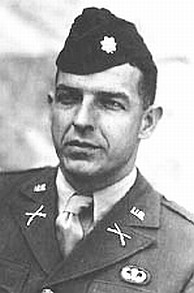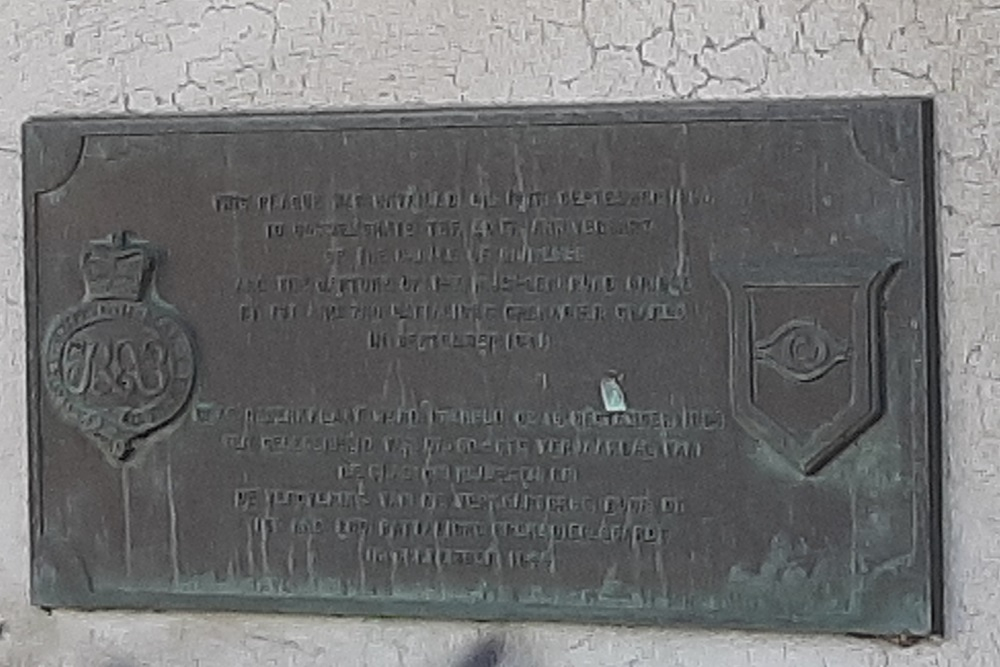Vandervoort, Benjamin Hayes "Vandy"
- Date of birth:
- March 3rd, 1915 (Gasport/New York, United States)
- Date of death:
- November 22nd, 1990 (Hilton Head Island/South Carolina, United States)
- Buried on:
- Beaufort National Cemetery
Plot: 20. Grave: 59. - Service number:
- O-22715
- Nationality:
- American (1776 - present, Republic)
Biography
Do you have more information about this person? Inform us!
- Period:
- Second World War (1939-1945)
- Rank:
- Lieutenant Colonel
- Unit:
- Commanding Officer, 2nd Battalion, 505th Parachute Infantry Regiment, 82nd Airborne Division "All American", U.S. Army
- Awarded on:
- July 1st, 1944
- Awarded for:
- Operation Detroit
"For extraordinary heroism in action against the enemy on 6 June 1944 near Sainte-Mère-Église, France. Though he sustained a broken foot in his jump, Lieutenant Colonel Vandervoort refused to be evacuated. He immediately, despite his painful injury, assembled and organized all the available troops from his battalion and personally led it through enemy held territory to the initial objective. With only first-aid treatment for his broken foot, he remained with his unit and directed the defense of its newly won position against a vastly superior enemy. With complete disregard for his own safety he continually moved about the foremost elements, subjecting himself to intense enemy rifle, machine gun and artillery fire. Inspired by his presence, his men successfully withstood repeated enemy counterattacks. The personal bravery, devotion to duty and outstanding leadership displayed by Lieutenant Colonel Vandervoort reflect great credit on himself and were in keeping with the highest traditions of the Armed Forces."
HQ First U.S. Army, GO 31, July 1st 1944.
- Period:
- Second World War (1939-1945)
- Rank:
- Lieutenant Colonel
- Unit:
- Commanding Officer, 2nd Battalion, 505th Parachute Infantry Regiment, 82nd Airborne Division "All American", U.S. Army
- Awarded on:
- January 22nd, 1945
Citation:
"For extraordinary heroism in connection with military operations against an armed enemy while serving as Commanding Officer of the 2d Battalion, 505th Parachute Infantry Regiment, 82d Airborne Division, in action against enemy forces in Holland from 17 to 23 September 1944. On 17 September the Second Battalion, 505th Parachute Infantry, Lieutenant Colonel Vandervoort commanding, landed near Groesbeek, Holland. Lieutenant Colonel Vandervoort hastened the reorganization and advanced with his leading element to capture the initial battalion objective in three and one half hours. On the afternoon of the 19th of September 1944, the Second Battalion moved into Nijmegen to attack prepared defensive positions including dug in anti-tank and machine gun nests and camouflaged snipers posts. Lieutenant Colonel Vandervoort supervised and directed the assault while continually under direct fire from these snipers. A coordinated attack was launched on the afternoon of 21 September 1944. Lieutenant Colonel Vandervoort established himself at a forward and exposed position to personally supervise and coordinate the progress of the Infantry and attached armored elements. Throughout the entire engagement, his total disregard for his own safety made possible the continued coordination which led to the final seizure of the bridge. Lieutenant Colonel Vandervoort's coolness, outstanding courage and initiative, and his resolute leadership contributed to the success of the mission of seizing intact the railway and highway bridges. His intrepid actions, personal bravery and zealous devotion to duty exemplify the highest traditions of the military forces of the United States and reflect great credit upon himself, the 82d Airborne Division, and the United States Army."
HQ XVIII Airborne Corps, GO 10, January 22nd, 1945.
Awarded as Oak Leaf Cluster to be worn on the ribbon of the first DFC.
"For extraordinary heroism in connection with military operations against an armed enemy while serving as Commanding Officer of the 2d Battalion, 505th Parachute Infantry Regiment, 82d Airborne Division, in action against enemy forces in Holland from 17 to 23 September 1944. On 17 September the Second Battalion, 505th Parachute Infantry, Lieutenant Colonel Vandervoort commanding, landed near Groesbeek, Holland. Lieutenant Colonel Vandervoort hastened the reorganization and advanced with his leading element to capture the initial battalion objective in three and one half hours. On the afternoon of the 19th of September 1944, the Second Battalion moved into Nijmegen to attack prepared defensive positions including dug in anti-tank and machine gun nests and camouflaged snipers posts. Lieutenant Colonel Vandervoort supervised and directed the assault while continually under direct fire from these snipers. A coordinated attack was launched on the afternoon of 21 September 1944. Lieutenant Colonel Vandervoort established himself at a forward and exposed position to personally supervise and coordinate the progress of the Infantry and attached armored elements. Throughout the entire engagement, his total disregard for his own safety made possible the continued coordination which led to the final seizure of the bridge. Lieutenant Colonel Vandervoort's coolness, outstanding courage and initiative, and his resolute leadership contributed to the success of the mission of seizing intact the railway and highway bridges. His intrepid actions, personal bravery and zealous devotion to duty exemplify the highest traditions of the military forces of the United States and reflect great credit upon himself, the 82d Airborne Division, and the United States Army."
HQ XVIII Airborne Corps, GO 10, January 22nd, 1945.
Awarded as Oak Leaf Cluster to be worn on the ribbon of the first DFC.
- Period:
- Second World War (1939-1945)
- Rank:
- Lieutenant Colonel
- Unit:
- Commanding Officer, 2nd Battalion, 505th Parachute Infantry Regiment, 82nd Airborne Division "All American", U.S. Army
- Awarded on:
- January 29th, 1945
For extraordinary service during the liberation of France (June - December 1944). Presented by General de Gaulle.
With aplm
With aplm
- Period:
- Second World War (1939-1945)
- Rank:
- Lieutenant Colonel
- Unit:
- Commanding Officer, 2nd Battalion, 505th Parachute Infantry Regiment, 82nd Airborne Division "All American", U.S. Army
- Awarded on:
- October 8th, 1945
Royal Decree No.31, October 8th, 1945
- Period:
- Second World War (1939-1945)
- Unit:
- Commanding Officer, 2nd Battalion, 505th Parachute Infantry Regiment, 82nd Airborne Division "All American", U.S. Army
With "V" device
- Period:
- Second World War (1939-1945)
- Period:
- Second World War (1939-1945)
- Period:
- Second World War (1939-1945)
Sources
- Photo 1: ww2-airborne.us
- - DE TREZ, M., Colonel Ben Vandervoort: The Way We Were, D-Day Publishing, Wezembeek-Oppem, Belgium, 2004.
- NORDYKE, P., All American All the Way, Zenith Press, St. Paul, United States, 2005.
- NORDYKE, P., An Irresistible Force, Historic Ventures, LLC, McKinney, United States, 2011.
- Home of Heroes.com
- The Dutch Medals Page
- WW2-Airborne.us
- The way we were - Col. Ben Vandervoort
- "Brons", Nr 66, 19e Jaargang, uitgave van de Vereniging Dragers Militaire Dapperheidsonderscheidingen 2010
- Eregallerij









